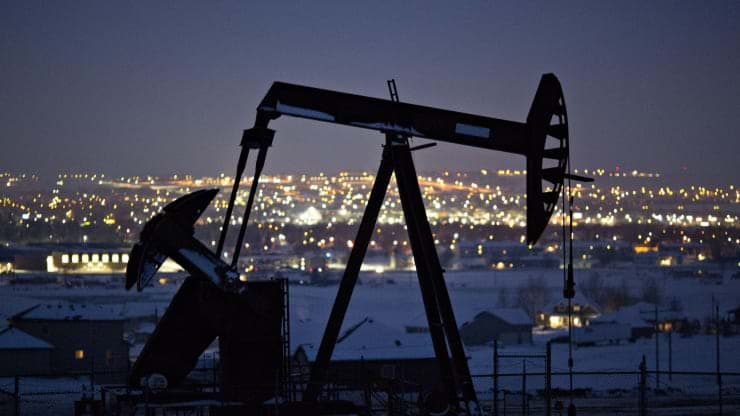The US Shale Revolution Won’t Stall Despite Headwinds, Global Oil Experts Say

The U.S. is expected to become a net energy exporter in 2020, exporting more energy products ranging from oil to natural gas, than it imports, according to the U.S. Energy Information Administration (EIA). Jason Bordoff, professor and director at Columbia University’s Center on Global Energy Policy and a former adviser to President Obama, told CNBC Monday that he didn’t think that status would be short-lived.
“I
don’t think the export story will be short-lived, I think the growth in
production is going to slow but it’s still growing, so we’re still going to see
the U.S. become a net oil exporter and put a lot of barrels on the market and
that’s really important,” he told CNBC’s Steve Sedgwick and Hadley Gamble at
the Abu Dhabi International Petroleum Exhibition & Conference (ADIPEC) on
Monday.
The
U.S. Department of Energy’s statistics bureau, the EIA, announced back in
January that it expected the U.S. to become a net energy exporter in 2020 for
the first time ever. It had been a net importer of energy since 1953, the EIA
noted in its annual energy outlook which makes projections for the next 50
years.
The
agency said the U.S. will start exporting more crude oil and petroleum products
than it imports by the final quarter of 2020, and then would remain a net oil
exporter for years to come. It noted, however, that production would increase
per year until 2027 when it would then level off.
The
net exporter status comes earlier-than-expected as a previous forecast believed
it would be achieved by 2022.
Revolution
to be continued?
Oil
supply and demand dynamics are being closely watched amid efforts by major oil
producers in OPEC, and non-OPEC producers led by Russia, to curb their oil
output in a bid to stabilize prices.
Tellingly,
U.S. shale producers have not been a part of the agreement to cut output to
support prices which have hovered around the $60 per barrel mark; on Monday,
benchmark Brent crude was trading at $61.97 per barrel and West Texas
Intermediate (WTI) at $56.71.
The
14-member global oil producer group OPEC said in its closely-watched World Oil
Outlook report released in early November that its own production of crude oil
and other liquids is expected to decline over the next five years, falling to
32.8 million b/d (barrels a day) in 2024, from a current level of 35 million
b/d in 2019.
The
U.S. Energy Information Administration projected U.S. crude output will rise to
12.3 million b/d in 2019 from a record 11.0 million barrels per day in 2018. It
forecasts that U.S. crude oil production will rise by 0.9 million b/d in 2020
to an annual average of 13.2 million b/d.
Yet
there are signs of moderation too. Baker Hughes’ closely-watched weekly Rig
Count data, seen as an early indicator of future output, on Friday showed that
there were 817 active rigs in the U.S. that week, down 264 from the same week
in 2018.
Lorenzo
Simonelli, chief executive of Baker Hughes, one of the world’s largest oil
field services firms, told CNBC Monday that a decline in capex (capital
expenditure, essentially, investment within an industry) was being witnessed in
the North American shale oil sector currently.
“We’re
seeing North America capex down in the fourth quarter as well as going in to
next year so it’s more challenging in North America than here in the Middle
East,” he said, agreeing that there was “definitely” less investment in shale
at the moment.
“We’re
looking at high single digit to low double-digit declines in capex (capital
expenditure) for our major customers in North America and that’s going to be
impacting shale,” he said.
OPEC’s
Secretary-General Mohammad Barkindo remarked to CNBC last week that U.S. shale
was facing challenges.
“We
have already started seeing a deceleration of growth in the United States. The
shale patch in the U.S. is facing a tremendous amount of headwinds as a result
of the unprecedented growth that we have seen in the last couple of years,”
Barkindo said.
Asked
if he agreed with Barkindo’s assessment of the U.S. shale production outlook,
Baker Hughes’ Simonelli said “it’s still early to say.”
“U.S.
production is still increasing, and even with the capex declines you’ve seen
productivity and efficiency so a lot is going to be seen in 2020 with U.S.
production, what’s going to happen in the fourth quarter of 2020 in U.S.
production,” he said, referring to the quarter when net energy exporter status
is expected to be reached.
Still
a boon to investors
The
U.S. shale industry is still attractive to companies like Mubadala, upstream
oil and gas exploration and production company and subsidiary of Abu Dhabi’s
state investment arm Mubadala.
Mubadala
Petroleum & Petrochemicals’ CEO Musabbeh Al Kaabi told CNBC on Monday that
the company had made a “substantial investment” in the U.S. petrochemical space
and an LNG developer, and was still optimistic about the region.
“We’re
still very bullish about the U.S.,” he told CNBC in Abu Dhabi. “By far, in the
last ten years, it is a true disruption in our energy landscape so we have made
a substantial investment, taking advantage of the opportunities offered by the
shale revolution in the U.S.”
He
said the company’s investments in the U.S. had been driven by the understanding
that “the shale revolution will continue” but worried about anti-fracking
comments from Democratic presidential nominee Liz Warren, who said she would
ban fracking “everywhere” if elected.
However, there are headwinds including what some of the Democratic nominees (in the U.S. election race) are promoting and I think the consequences of these decisions need to be evaluated and fully understood. It might be a very challenging decision to switch off the activity,” he said.
